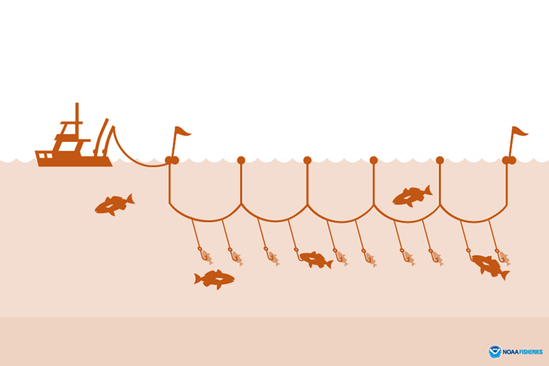A decision in 2020 by the Hawaii Longline Association to ban the use of wire leaders in the tuna fleet’s fishing equipment has paved the way to help save the imperiled Pacific oceanic whitetip shark from extinction.
Last year the Hawaii fleet’s approximately 140 vessels replaced the steel wire fishing leaders at the ends of their fishing lines with ones made from less-lethal nylon, or monofilament.

Targeting tuna, swordfish and other pelagic fish, longlines can stretch from a mile on smaller boats, to over 60 miles in an industrial vessel. On a large vessel thousands of baited hooks are set and left adrift for over 24 hours to several days. Longlines consist of a buoyed free- drifting mainline (also called a trunkline) with hundreds or even thousands of smaller lines (leaders) with baited hooks at the end. The leader is the part of the gear between the long or (trunk) line and the hook. The baited hooks also catch and kill albatross, sea turtles, pilot whales, Risso’s dolphins and bottlenose dolphins, and other species of sharks.
The gear change from metal leaders to monofilament will help endangered and overfished sharks killed as bycatch, because the sharks can bite through the nylon more easily and free themselves while the targeted catch is maintained on the line.
It is estimated by NMFS that about 1,500 oceanic whitetips get caught in Hawaii Longline Association’s (HLA) gear each year, representing about 4% of all the Oceanic whitetip catches in the Pacific. Some 30% to 40% of those sharks die after getting caught, according to a HLA spokesman.
Oceanic whitetip sharks are listed as threatened under the Endangered Species Act in 2018 and critically endangered under the International Union for the Conservation of Nature Red List.
A report from the National Marine Fisheries Service found that 53,500 oceanic whitetip sharks were caught by western and central Pacific fishing fleets each year on average from 2013 to 2017. That included some 1,700 catches a year by Hawaii’s deep-set longline vessels.
The Western Pacific Regional Fishery Management Council, or WESPAC, which oversees commercial fishing in vast area west and south of Hawaii, released a report last year indicating only 5% of oceanic whitetip sharks remain in the Pacific. At the December 2022 meeting to set quotas and fishing policy, WESPAC agreed to a proposal by the USA and Canada to outlaw shark lines and wire leaders. Both are used by industrial-scale fishers targeting sharks and leading to major declines in Pacific shark populations.
Also in the proposal is a requirement that sharks like oceanic whitetips, which cannot be retained under any circumstances, be freed with as little fishing gear as possible remaining attached to their bodies.
Shark Stewards thanks Hawaiian fishermen and NOAA for establishing policies and practices to protect endangered pelagic sharks in the Pacific. In 2023 we will help carry this success to the Eastern pacific at Inter-American Tropical Tuna Commission (IATTC) to protect endangered pelagic and migratory sharks like oceanic whitetip, silky, and hammerhead sharks.
It is estimated by NMFS that about 1,500 oceanic whitetips get caught in Hawaii Longline Association’s (HLA) gear each year, representing about 4% of all the Oceanic whitetip catches in the Pacific. Some 30% to 40% of those sharks die after getting caught, according to a HLA spokesman.
Oceanic whitetip sharks are listed as threatened under the Endangered Species Act in 2018 and critically endangered under the International Union for the Conservation of Nature Red List.
A report from the National Marine Fisheries Service found that 53,500 oceanic whitetip sharks were caught by western and central Pacific fishing fleets each year on average from 2013 to 2017. That included some 1,700 catches a year by Hawaii’s deep-set longline vessels.
The Western Pacific Regional Fishery Management Council, or WESPAC, which oversees commercial fishing in vast area west and south of Hawaii, released a report last year indicating only 5% of oceanic whitetip sharks remain in the Pacific. At the December 2022 meeting to set quotas and fishing policy, WESPAC agreed to a proposal by the USA and Canada to outlaw shark lines and wire leaders. Both are used by industrial-scale fishers targeting sharks and leading to major declines in Pacific shark populations.
Also in the proposal is a requirement that sharks like oceanic whitetips, which cannot be retained under any circumstances, be freed with as little fishing gear as possible remaining attached to their bodies.
Shark Stewards is grateful to the Hawaiian fishermen and NOAA for setting a global example establishing policies and practices to protect endangered pelagic sharks in the Pacific. In 2023 we will help carry this success to the Eastern Pacific by pressuring the Inter-American Tropical Tuna Commission (IATTC) to adopt these requirements and protect endangered pelagic and migratory sharks like oceanic whitetip, silky, and hammerhead sharks.